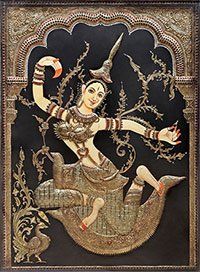Nihshreyasa, Niḥśreyasa, Nis-shreyasa, Nishshreyasa: 10 definitions
Introduction:
Nihshreyasa means something in Hinduism, Sanskrit, Hindi. If you want to know the exact meaning, history, etymology or English translation of this term then check out the descriptions on this page. Add your comment or reference to a book if you want to contribute to this summary article.
The Sanskrit term Niḥśreyasa can be transliterated into English as Nihsreyasa or Nihshreyasa, using the IAST transliteration scheme (?).
Alternative spellings of this word include Nisreyas.
In Hinduism
Sports, Arts and Entertainment (wordly enjoyments)
Source: archive.org: Syainika Sastra of Rudradeva with English Translation (art)Niḥśreyasa (निःश्रेयस) refers to the “highest (object of desire)”, according to the Śyainika-śāstra: a Sanskrit treatise dealing with the divisions and benefits of Hunting and Hawking, written by Rājā Rudradeva (or Candradeva) in possibly the 13th century.—Accordingly, “[...] If one’s merit is so great that one can aim at the attainment of the highest (niḥśreyasa) object of desire, one should give up all activities [yadi niḥśreyase saṅgajihāsā karmaṇāmbhavet] and practise complete renouncement. It is known from the Śāstras that even the enjoyment of the fruits of action causes annihilation of the fruits of activity, as in the case of the wise Saubhari, who enjoyed the objects of his senses for the release from bondage. [...]”.

This section covers the skills and profiencies of the Kalas (“performing arts”) and Shastras (“sciences”) involving ancient Indian traditions of sports, games, arts, entertainment, love-making and other means of wordly enjoyments. Traditionally these topics were dealt with in Sanskrit treatises explaing the philosophy and the justification of enjoying the pleasures of the senses.
Languages of India and abroad
Sanskrit dictionary
Source: DDSA: The practical Sanskrit-English dictionaryNiḥśreyasa (निःश्रेयस).—[niścitaṃ śreyaḥ ni°]
1) Final beatitude, absolution; स स्थाणुः स्थिरभक्तियोगसुलभो निःश्रेयसायास्तु वः (sa sthāṇuḥ sthirabhaktiyogasulabho niḥśreyasāyāstu vaḥ) V.1.1; समुत्कर्षनिःश्रेयसस्यैकमुग्रं परं साधनं नाम वीरव्रतम् (samutkarṣaniḥśreyasasyaikamugraṃ paraṃ sādhanaṃ nāma vīravratam) Subhāṣ; Ki. 11.19.
2) Happiness; Manusmṛti 1.16.
3) Faith, belief.
4) Apprehension, conception.
Derivable forms: niḥśreyasam (निःश्रेयसम्).
--- OR ---
Niḥśreyasa (निःश्रेयस).—a. the best, most excellent.
-saḥ an epithet of Śiva.
-sam final beatitude, absolution; यः करोति वधोदर्का निःश्रेयसकरीः क्रियाः (yaḥ karoti vadhodarkā niḥśreyasakarīḥ kriyāḥ) Kirātārjunīya 11.19; see निःश्रेयस (niḥśreyasa) also.
Niḥśreyasa is a Sanskrit compound consisting of the terms nis and śreyasa (श्रेयस).
Source: Cologne Digital Sanskrit Dictionaries: Cappeller Sanskrit-English DictionaryNiḥśreyasa (निःश्रेयस).—[feminine] ī best, most excellent (lit. having no better or superior); [neuter] bliss, deliverance, final beatitude, happiness, welfare.
Source: Cologne Digital Sanskrit Dictionaries: Monier-Williams Sanskrit-English Dictionary1) Niḥśreyasa (निःश्रेयस):—[=niḥ-śreyasa] [from niḥ] mf(ī)n. ‘having no better’, best, most excellent, [Mahābhārata; Rāmāyaṇa] etc.
2) [v.s. ...] m. Name of Śiva, [cf. Lexicographers, esp. such as amarasiṃha, halāyudha, hemacandra, etc.]
3) [v.s. ...] n. the best id est. ultimate bliss, final beatitude, or knowledge that brings it, [Kauṣītaki-upaniṣad; Manu-smṛti; Mahābhārata] etc.
4) [v.s. ...] belief, faith, [cf. Lexicographers, esp. such as amarasiṃha, halāyudha, hemacandra, etc.]
5) [v.s. ...] apprehension, conception, [cf. Lexicographers, esp. such as amarasiṃha, halāyudha, hemacandra, etc.]
Source: Cologne Digital Sanskrit Dictionaries: Yates Sanskrit-English DictionaryNiśśreyasa (निश्श्रेयस):—[niś-śreyasa] (saṃ) 1. n. Final bliss.
Source: DDSA: Paia-sadda-mahannavo; a comprehensive Prakrit Hindi dictionary (S)Niḥśreyasa (निःश्रेयस) in the Sanskrit language is related to the Prakrit word: Ṇisseyasa.
[Sanskrit to German]
Sanskrit, also spelled संस्कृतम् (saṃskṛtam), is an ancient language of India commonly seen as the grandmother of the Indo-European language family (even English!). Closely allied with Prakrit and Pali, Sanskrit is more exhaustive in both grammar and terms and has the most extensive collection of literature in the world, greatly surpassing its sister-languages Greek and Latin.
Hindi dictionary
Source: DDSA: A practical Hindi-English dictionaryNiḥśreyasa (निःश्रेयस) [Also spelled nisreyas]:—(nm) the summun bonum, highest good.
...
Kannada-English dictionary
Source: Alar: Kannada-English corpusNiḥśrēyasa (ನಿಃಶ್ರೇಯಸ):—[noun] the everlasting freedom and joy, which the virtuous souls are believed to attain after getting emancipated from the worldly life.
--- OR ---
Niśśrēyasa (ನಿಶ್ಶ್ರೇಯಸ):—[noun] = ನಿಶ್ರೇಯಸ್ಸು [nishreyassu].
Kannada is a Dravidian language (as opposed to the Indo-European language family) mainly spoken in the southwestern region of India.
See also (Relevant definitions)
Partial matches: Shreyasa, Nih, Nish.
Starts with: Nihshreyasakara.
Full-text: Nishshreyasa, Nishshreyasakara, Nihshreyasakara, Nishreyasa, Nisseyasa, Naishreyasika, Nisreyas, Pratipakshata, Nihshreya, Ayushya, Naihshreyasa, Raddha, Apavarga, Pad.
Relevant text
Search found 17 books and stories containing Nihshreyasa, Nih-shreyasa, Niḥ-śreyasa, Nih-sreyasa, Nih-śrēyasa, Niḥśreyasa, Nihsreyasa, Niḥśrēyasa, Nihśrēyasa, Nis-shreyasa, Nis-śreyasa, Nis-sreyasa, Niś-śreyasa, Nish-shreyasa, Nishreyasa, Nishshreyasa, Niśrēyasa, Niśśreyasa, Niśśrēyasa; (plurals include: Nihshreyasas, shreyasas, śreyasas, sreyasas, śrēyasas, Niḥśreyasas, Nihsreyasas, Niḥśrēyasas, Nihśrēyasas, Nishreyasas, Nishshreyasas, Niśrēyasas, Niśśreyasas, Niśśrēyasas). You can also click to the full overview containing English textual excerpts. Below are direct links for the most relevant articles:
Manusmriti with the Commentary of Medhatithi (by Ganganatha Jha)
Verse 1.117 < [Section LXII - Contents of the Treatise]
Verse 1.106 < [Section LXI - Results accruing from the study of the Institutes]
Vaisheshika-sutra with Commentary (by Nandalal Sinha)
Sūtra 1.1.2 (Definition of Dharma) < [Chapter 1 - Of Substance, Attribute, and Action]
Sūtra 1.1.4 (Knowledge of Predicates) < [Chapter 1 - Of Substance, Attribute, and Action]
Shrimad Bhagavad-gita (by Narayana Gosvami)
Verse 5.2 < [Chapter 5 - Karma-sannyāsa-yoga (Yoga through Renunciation of Action)]
Verse 3.26 < [Chapter 3 - Karma-yoga (Yoga through the Path of Action)]
The validity of Anumana (inference) in Nyaya system (by Babu C. D)
Buddha-nature (as Depicted in the Lankavatara-sutra) (by Nguyen Dac Sy)
2. Hindu Philosophical Systems (c) Nyāya < [Chapter 3 - The Laṅkāvatārasūtra and Hindu Philosophy]
Atithi or Guest Reception (study) (by Sarika. P.)